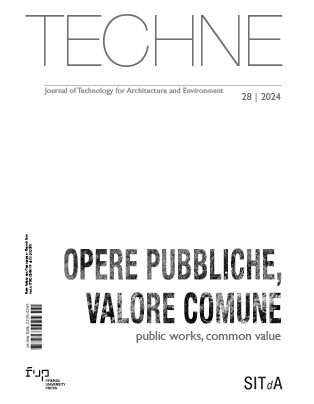Published 2024-10-29
Keywords
- Public work,
- Adaptive reuse,
- multi-actor approach,
- public-private partnership,
- complex social value
How to Cite
Copyright (c) 2024 Antonella Violano, Francesca Muzzillo, Desmond Hui

This work is licensed under a Creative Commons Attribution 4.0 International License.
Abstract
The comparison between EU cohesion policies on public works as a common good and Hong Kong’s policies on public-private participation to preserve and revitalise architectural heritage highlights cultural and operational differences. While Europe often adopts an inclusive approach, involving the communities mainly in the valorisation of public spaces, Hong Kong implements models more focused on public-private partnership to preserve the public real estate. Thus, the adaptive reuse of public works at the two different scales transforms public works into catalysts of prosperity for the community by preserving historical memory, but has a different impact on shared value generation, social cohesion enhancement, sustainable development promotion, and collective identity valorisation. The contribution analyses the two models (centrifugal and centripetal), focusing on objectives and implementation tools.
Downloads
References
- AA.VV. (2019), “Practice Guidebook for Adaptive Re-use of and Alteration and Addition Works to Heritage Buildings” (2019 Edition), Hong Kong Building Department. Available at: https://www.heritage.gov.hk/filemanager/heritage/Publication/en/upload/9/heritage_2019.pdf.
- Attia S. (2018), “Regenerative and Positive Impact Architecture. Learning from Case Studies”, Springer Nature, Cham, Switzerland.
- Augustiniok, N., Claudine, H., Plevoets, B. and Van Cleempoel, K. (2023), “Adaptive reuse of built heritage: conserving and designing with values”, Journal of Cultural Heritage Management and Sustainable Development. Available at: https://doi.org/10.1108/JCHMSD-05-2023-0068. DOI: https://doi.org/10.1108/JCHMSD-05-2023-0068
- Berkes, F., Colding, J. and Folke, C. (Eds.). (2008), “Navigating social-ecological systems: building resilience for complexity and change”, Cambridge University Press.
- Chou, J.R. (2021), “A Scoping Review of Ontologies Relevant to Design Strategies in Response to the UN Sustainable Development Goals (SDGs)”, Sustainability 2021, Vol. 13, p. 10012. Available at: https://doi.org/10.3390/su131810012. DOI: https://doi.org/10.3390/su131810012
- European Commission (2021), COM(2021) 573 final, ANNEX 1 https://new-european-bauhaus.europa.eu/system/files/2021-09/COM%282021%29_573_1_IT_annex.PDF (Accessed on 1 March 2024).
- EEA Report (2022). Urban sustainability in Europe. Post‑pandemic drivers of environmental transitions. 06/2022, Publications Office of the European Union, Luxembourg
- Fusco Girard L. (2020), “The circular economy in transforming a died heritage site into a living ecosystem, to be managed as a complex adaptive organism”, AESTIMUM 77, 12.2020, FUP, pp.145-180. Available at: https://doi.org/10.13128/aestim-9788.
- Fusco Girard, L. and Vecco, M. (2021), “The “Intrinsic Value” of Cultural Heritage as Driver for Circular Human-Centered Adaptive Reuse”, Sustainability 2021, Vol. 13, p. 3231. Available at: https://doi.org/10.3390/su13063231. DOI: https://doi.org/10.3390/su13063231
- IPCC (2023), Climate Change 2023: Synthesis Report. Contribution of Working Groups I, II and III to the Sixth Assessment Report of the Intergovernmental Panel on Climate Change [Core Writing Team, H. Lee and J. Romero (eds.)]. IPCC, Geneva, Switzerland, 184 pp., https://doi.org/10.59327/IPCC/AR6-9789291691647. DOI: https://doi.org/10.59327/IPCC/AR6-9789291691647
- Losasso, M. (2018), “Design, Environment, Resilience”. TECHNE – Journal of Technology for Architecture and Environment, Vo. 15, pp.16-20. Available at: https://doi.org/10.13128/Techne-23195.
- Pallasmaa J., (1996), “The Eyes of the Skin. Architecture and the Senses”. John Wiley, p. 22.
- Rykwert J., (1976), “The Idea of Town”. Princeton University Press Adelphi, p. 26 (1st edition 1963).
- Violano, A. and Maio, A. (2024), “The Regeneration of Architectural Heritage to Manage the Reversibility of Adaptive Reuse Technology Design: Two Italian Case Studies”. In: Battisti, A., Baiani, S. (Eds.) ETHICS: Endorse Technologies for Heritage Innovation. Designing Environments. Springer, Cham. Available: https://doi.org/10.1007/978-3-031-50121-0_13. DOI: https://doi.org/10.1007/978-3-031-50121-0_13






